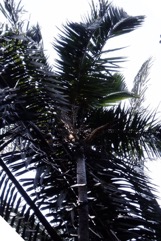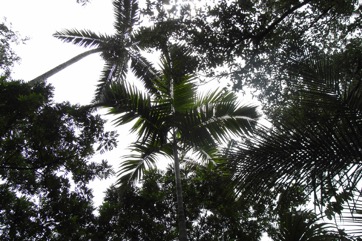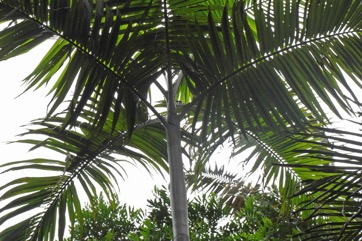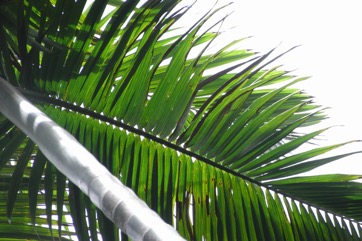Calappa palm

A tropical plant. It is widespread in Papua New Guinea. It grows in rainforest. It grows in well-drained rich soil with an abundance of moisture. It grows up to 1,000 m altitude. It grows in the Loyalty and Treasury Islands.
Also known as:
Boluru, Jawar, Jebug sari, Pinang hantu, Pinang kelapa, Pinang penawar, Pinang sendawa, Pomau, Vekaveke
Synonyms
- Actinorhytis pomau Becc.
- Areca calapparia Blume
- Areca cocoides Griff.
- Pinanga calapparia (Blume) H. Wendl. [Illegitimate]
- Ptychosperma calapparia (Blume) Miq.
- Seaforthia calapparia (Blume) Mart.
Edible Portion
- Kernel, Cabbage, Nuts masticatory, Palm heart
Where does Calappa palm grow?
Found in: Asia, Australia, India, Indonesia, Malaysia, Pacific, Papua New Guinea, PNG, SE Asia, Solomon Islands
Notes: There are 2 Actinorhytis species.
Status: It is not known if it is used for food in Papua New Guinea.
Growing Calappa palm
Cultivation: Plants can be grown from seeds.
Edible Uses: The young nut is chewed like betel nut. It is very strong. The palm heart is eaten.
Nutrition Info
per 100g edible portion| Edible Part | Energy (kcal) | Protein (g) | Iron (mg) | Vitamin A (ug) | Vitamin c (mg) | Zinc (mg) | % Water |
|---|---|---|---|---|---|---|---|
| Nuts | - | - | - | - | - | - | |
| Palm heart | - | - | - | - | - | - |
Calappa palm Photos




References
Baker, W.J. and Dransfield, J., 2006, Field Guide to Palms of New Guinea. Kew p 48
Balick, M.J. and Beck, H.T., (Ed.), 1990, Useful palms of the World. A Synoptic Bibliography. Colombia p 404,
Barfod, A.S., Banka R., and Dowe, J. L., 2001, Field Guide to Palms in Papua New Guinea. AAU Reports 40 Department of Systematic Botany University of Aarhus. Denmark. p 62
Burkill, I.H., 1966, A Dictionary of the Economic Products of the Malay Peninsula. Ministry of Agriculture and Cooperatives, Kuala Lumpur, Malaysia. Vol 1 (A-H) p
Essig, F.B., 1977, The palm Flora of New Guinea. Botany Bulletin No 9. Papua New Guinea Division of Botany. Lae, Papua New Guinea. p 24 Plate 7 (Photo)
Essig, F.B., 1995, A checklist and analysis of the palms of the Bismarck Archipelago. Principes 39(3):123-129
French, B.R., 2010, Food Plants of Solomon Islands. A Compendium. Food Plants International Inc. p 283
French, B.R., 2010, Food Plants of Solomon Islands. A Compendium. Food Plants International Inc. p 284 (As Actinorhytis poamau)
Haynes, J., & McLaughlin, J., 2000, Edible palms and Their Uses. University of Florida Fact sheet MCDE-00-50-1 p 2
Johnson, D.V., 1998, Tropical palms. Non-wood Forest products 10. FAO Rome. p 79
Jones, D.L., 1994, Palms throughout the World. Smithtonian Institution, Washington. p 118
Jones, D.L., 2000, Palms of Australia 3rd edition. Reed/New Holland. p 113
Jones, D.L., 1994, Palms throughout the World. Smithtonian Institution, Washington. p 118 (As Actinorhytis poamau)
Linnaea 39:184. 1875
Menninger, E.A., 1977, Edible Nuts of the World. Horticultural Books. Florida p 124 (Incl. picture)
Peekel, P.G., 1984, (Translation E.E.Henty), Flora of the Bismarck Archipelago for Naturalists, Division of Botany, Lae, PNG. p 58 (Drawing)
Riffle, R.L. & Craft, P., 2003, An Encyclopedia of Cultivated Palms. Timber Press. p 23, 244
Sukarya, D. G., (Ed.) 2013, 3,500 Plant Species of the Botanic Gardens of Indonesia. LIPI p 748
World Checklist of Useful Plant Species 2020. Royal Botanic Gardens, Kew